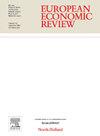Public debt burden and crisis severity
IF 2.4
2区 经济学
Q1 ECONOMICS
引用次数: 0
Abstract
Recent theoretical studies have highlighted that both the level of public debt and the unit cost of servicing the debt () play a role in the sustainability of public finances. This paper builds on this literature and introduces a new approach to analysing the relationship between economic downturns and sovereign debt risks by considering the total public debt burden, that is, the interaction between the level of debt and . We conduct this analysis for 18 advanced economies over a span of 150 years, uncovering three novel findings. First, we document that the level of public debt and the interest-growth differential convey distinct information about public finances conditions, reinforcing the argument for incorporating both measures in the assessment of sovereign debt sustainability risks. Second, we offer a long-term historical perspective on the role of the total public debt burden in shaping the severity of recessions and the pace of subsequent recoveries. Our findings demonstrate that a high public debt burden is associated with deeper economic contractions, sharper declines in investment, deflationary pressures, and pronounced credit contractions during recessions. Further analysis of plausible transmission mechanisms suggests that an elevated total debt burden at the onset of recessions is linked to more limited accommodative policies during financial crises. Third, we document the feedback effects of financial crises on the components of the total public debt burden, demonstrating that both the level and cost of public debt systematically deteriorate, thereby heightening the risk of sovereign debt crises in the aftermath of financial turmoil.
公共债务负担和危机严重程度
最近的理论研究强调,公共债务水平和偿还债务的单位成本(r - g)对公共财政的可持续性都有影响。本文以这些文献为基础,引入了一种新的方法,通过考虑公共债务负担总额,即债务水平与r - g之间的相互作用,来分析经济衰退与主权债务风险之间的关系。我们对18个发达经济体在150年的时间里进行了分析,发现了三个新的发现。首先,我们证明了公共债务水平和利率增长差异传达了关于公共财政状况的不同信息,从而加强了将这两种指标纳入主权债务可持续性风险评估的论点。其次,我们从长期的历史角度来看待公共债务负担总额在影响经济衰退的严重程度和随后复苏的速度方面所起的作用。我们的研究结果表明,在经济衰退期间,高公共债务负担与更深的经济收缩、投资急剧下降、通缩压力和明显的信贷收缩有关。对看似合理的传导机制的进一步分析表明,在衰退开始时债务总负担的增加与金融危机期间更为有限的宽松政策有关。第三,我们记录了金融危机对公共债务总负担组成部分的反馈效应,表明公共债务水平和成本都在系统性地恶化,从而加剧了金融动荡后主权债务危机的风险。
本文章由计算机程序翻译,如有差异,请以英文原文为准。
求助全文
约1分钟内获得全文
求助全文
来源期刊

European Economic Review
ECONOMICS-
CiteScore
4.70
自引率
3.60%
发文量
170
期刊介绍:
The European Economic Review (EER) started publishing in 1969 as the first research journal specifically aiming to contribute to the development and application of economics as a science in Europe. As a broad-based professional and international journal, the EER welcomes submissions of applied and theoretical research papers in all fields of economics. The aim of the EER is to contribute to the development of the science of economics and its applications, as well as to improve communication between academic researchers, teachers and policy makers across the European continent and beyond.
 求助内容:
求助内容: 应助结果提醒方式:
应助结果提醒方式:


